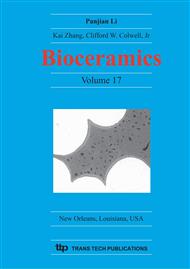p.373
p.377
p.381
p.387
p.391
p.395
p.399
p.403
p.407
SEM/EDX and FTIR Characterization of a Dental Resin Cement with Antibacterial Agents Incorporated
Abstract:
The demand from patients for aesthetic in posterior teeth restoration has been increasing in recent years. As an alternative to metal alloy restorations used in posterior tooth, aesthetical materials such as ceramics have been more often utilized. Resin cement, a derivative from dental composite, based on the combination of bis-GMA and inorganic filler is used to fixate these ceramic restorations to posterior teeth. Similar to resin composite, incorporated antibacterial agents to resin cement can be an effective way to increase the aesthetic restoration durability. Resin cements C&B® (Bisco) and Fill Magic Dual Cement® (Vigodent) were used in the present study. For experimental resin cement, Triclosan was incorporated to the base cement paste. Samples were investigated by Scanning Electron Microscopy coupled to EDX microprobe (SEM/EDX) and FTIR spectroscopy. The results have demonstrated that the incorporation of antibacterial agents to resin cement is possible through the developed procedure.
Info:
Periodical:
Pages:
391-394
Citation:
Online since:
April 2005
Price:
Сopyright:
© 2005 Trans Tech Publications Ltd. All Rights Reserved
Share:
Citation:


